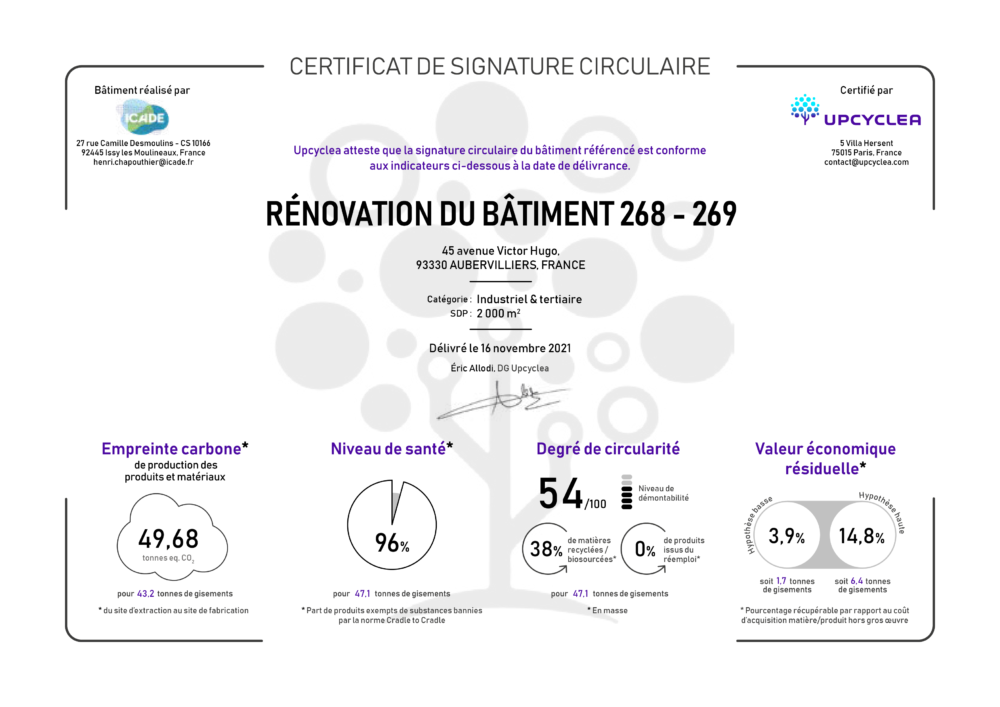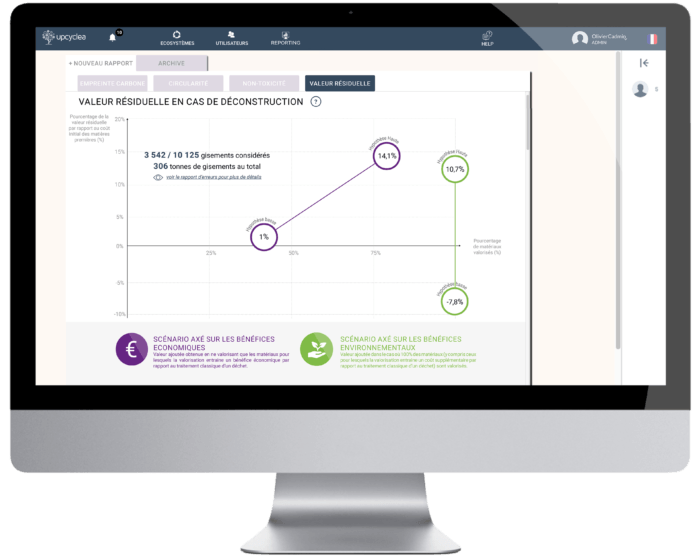Circular
Signature
The European reference for circular indicators
The Circular Signature® is a quantified translation of the ecological performance of a building or a real estate portfolio. It is calculated from the Circular Passport® data of the chosen materials and the eco-design or inventory data of the existing materials
It measures the CO2 footprint, the level of health, the degree of circularity and the share of reused, recycled and biobased materials. It thus allows to certify the environmental quality of a new or rehabilitated project
The Circular Signature® can also be used to calculate the residual economic value of a building or a deposit (i.e., the income recoverable from the sale of materials at the end of their useful life). It is expressed – in high and low assumptions – as a function of the acquisition cost of new products and the preferred recycling scenarios

How to use the Circular Signature?

In the Pre-Project phase, the Circular Signature® allows different simulations to be carried out in order to select the products with the best circular performance
In the execution phase, it is used to control the quality and conformity of the installed products
In the final delivery phase, the signature guarantees the “as built” environmental performance requested by the owner
The 4 indicators of the Circular Signature
The Circular Signature® is obtained by combining the data from the Circular Passports® and the Circular Signature®.
with the volume of products used. The myUpcyclea® system then draws 4 key indicators:
Carbon footprint
The carbon footprint measures the greenhouse gas emissions of human origin, for a building or an asset
myUpcyclea® calculates :
- The carbon footprint of product production from the extraction of raw materials to the final integration of the product, including all intermediate manufacturing steps
- The total footprint (Embodied Carbon)
- ICcomponent and ICconstruction indicators of the RE2020 for new buildings
The level of health
The health level is based on Cradle to Cradle®, the international circular economy label for products, including compliance with the list of molecules banned by the label.
It distinguishes 4 categories:
- Healthy products: These products do not contain any CMR substances (Carcinogenic, Mutagenic, Reprotoxic) and their VOC emissions (Volatile Organic Compounds) are controlled for a better indoor air quality
- Products with controlled and verified toxicity: These products do not contain any substance banned by the C2C beyond the tolerated thresholds, and this has been verified by an independent third-party organization
- Products with controlled toxicity, not verified by a third party
- Products with proven or unknown toxicity
Degree of circularity
The circularity indicator is the result of an operation that takes into account both the previous lives of the materials that make up the deposits considered, and the next possible uses for these deposits of used products
This indicator provides the following information:
- The rate of deposits with identified future uses
- The rate of recycled or rapidly renewable materials incorporated into products
- The degree of demountability of products and deposits
- The degree of reliability of the information available in the circular passports
Financial residual value
The financial residual value makes it possible to evaluate what income could potentially be generated through the circular management of the building’s used resources
It takes into account the value of the material at the end of the period of use and integrates the extra costs of clean disposal, as well as the savings compared to a classic waste management
The calculations are made according to 3 scenarios:
- Deconstruction: Value corresponding to the immediate recovery of all the used components of the building, from the structure to the furniture
- Renovation: Value corresponding to an immediate recovery of all the used components of a building, except those of the structure
- Renovation over 30 years: Value corresponding to a recovery of all the used components of a building over 30 years, taking into account their renewal frequency during this period
